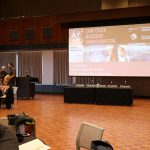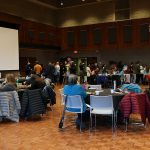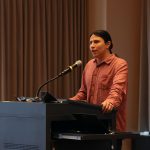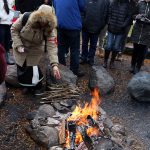By Katie Rice
Medill Reports
Otto Braided Hair stands at the lectern, praying in the Cheyenne language. It’s a prayer to “focus thoughts on the future,” he says. And though the majority of the people assembled don’t speak Cheyenne, the sentiment transcends language barriers. Everyone in the room undeerstands, from the people standing with heads bowed and hands clasped reverently to those sitting and silently reflecting.
They gathered at Northwestern University last Saturday afternoon to commemorate the Sand Creek Massacre. Members of the Northwestern University community, the Chicago American Indian community and descendants of victims of the Colorado massacre are here in remembrance of those killed and in acknowledgement of Northwestern University’s connection to the massacre itself.
On Nov. 29, 1864, U.S. Army soldiers from the 1st Regiment Cavalry and the 3rd Regiment Cavalry ambushed a Cheyenne and Arapaho village near modern-day Eads, Colorado, and killed more than 230 people, according to the National Park Service. History remembers this as the Sand Creek Massacre, named for the Big Sandy Creek near where the village stood.
John Evans, one of the founders of Northwestern University and th man for whom Evanston is named, was the governor of the Colorado Territory from 1862-1865. His role in the Sand Creek Massacre was scrutinized in a 2014 report published by Northwestern University and a report published the same year by the University of Denver.
Northwestern University’s committee found that Evans neither helped plan the massacre nor knew of it ahead of time, while the University of Denver’s committee found him “seriously culpability [sic] for helping creating the circumstances that led to the Sand Creek Massacre.”
According to the History Channel’s website, John Evans openly encouraged violence against the American Indian populations of the eastern Colorado Territory, issuing a proclamation that white settlers should “kill and destroy all…hostile Indians” and creating a militia to carry out such violence.
At the Sand Creek Massacre Commemoration, Jabbar Bennett, the associate provost and chief diversity officer at Northwestern University, expressed the importance of the University’s recognition of its ties to the Sand Creek Massacre and support for the Cheyenne and Arapaho communities going forward.
“Sand Creek, and John Evans’ involvement in Sand Creek, are not just a part of Cheyenne and Arapaho history, but a part of Northwestern[’s] and Evanston’s history as well,” Bennett said.
The event, which fell on Nov. 17 this year, is an annual commemoration started in 2014 through initiatives by the Native American and Indigenous Student Alliance (NAISA) to get more recognition of John Evans’ role in the massacre.
“When we were planning that first commemoration in 2014, I didn’t foresee it becoming what it is now,” said Forrest Bruce, secretary of the board of directors for the American Indian Center of Chicago and a Northwestern University alumnus.
“When I came here as a freshman, there was absolutely no talk about John Evans or Sand Creek — no recognition of that history. And that was six years ago, and now here we are. … We have an amazing group of faculty, students, staff and alumni who are committed to building that future, so let’s keep growing.”
During the commemoration, Jasmine Gurneau, the senior program coordinator for Native American and Indigenous Initiatives in the Office of Institutional Diversity and Inclusion, introduced the short documentary “Only the Mountains and the Earth.” The film featured the descendants of victims of the Sand Creek Massacre and discussed the lasting impact of the tragedy on the Cheyenne and Arapaho communities.
As the film continued, a box of tissues made its way around the room, passed from person to person. Lasting sorrow echoed throughvoices as interviewees in the film recounted scenes of incredible violence. In one scene, an interviewee shared that the Denver City Hall in Denver, Colorado, prominently displayed the framed scalp of a Native person murdered in the massacre for decades afterward.
After the screening, descendants of victims of the Sand Creek Massacre shared their experiences living with the Sand Creek Massacre’s infamy. Otto Braided Hair (Northern Cheyenne), Karen Little Coyote (Southern Cheyenne), Fred Mosqueda (Southern Arapaho) and Gail Ridgely (Northern Arapaho) all stressed the importance of remembering those killed in the massacre and honoring their memory while learning lessons from history.
“We’ve got all the history behind our tribes, to say that we’ve made it,” Karen Little Coyote said. “Our relatives were strong and believed in the same power of prayer.”
All speakers agreed that the Sand Creek Massacre left a lasting impact on their communities that continues to reverberate today.
“Every day, Sand Creek’s always on my mind,” said Mosqueda.
Beatriz Reyes, a lecturer in the Global Health Studies program at Northwestern University and an affiliated faculty member for the University’s Center for Native American and Indigenous Research, said this year’s commemoration differed from those of years past in that it had better attendance and the event was centered around the descendants.
For her, the biggest takeaway from the event was the movement toward institutions recognizing their sometimes problematic roles in history and correcting those historic wrongs going forward.
“Universities like Northwestern have a lot of responsibility to recognizing the history of their institutions and the land that they benefit from using for their institutions,” she said. “I think Northwestern is doing a great job of starting that process here.”
Anthony Tamez said he is part of the Native community of Chicago, and he came to the commemoration to show his support for his community.
“[The event is] acknowledging our history, and it’s acknowledging the faults that the United States has,” he said. “We can use it as a teaching moment, and we can use it as a cultural moment to learn and grow from each other.”












